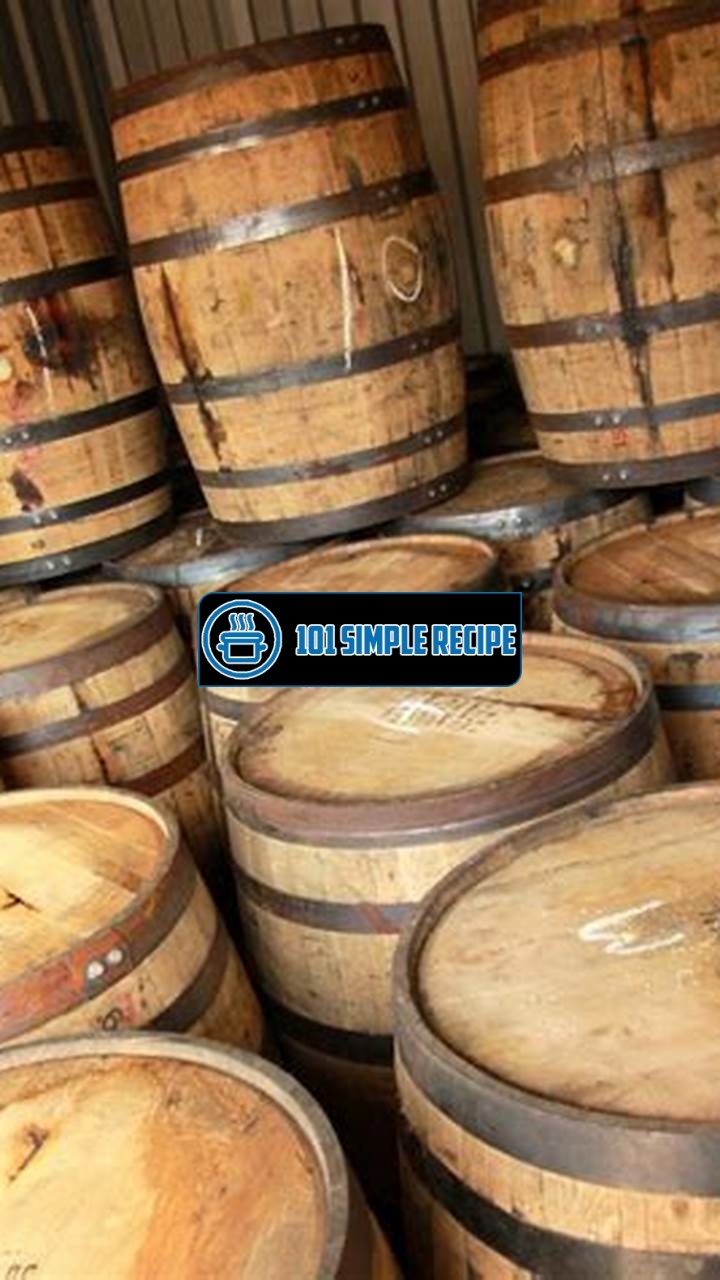Are you a beer enthusiast who loves to savor the rich flavors and aromas of a perfectly crafted barrel? If so, you’re in luck! In this article, we will unveil the secrets behind crafting the perfect barrel of beer. Whether you’re a homebrewer looking to enhance your skills or simply curious about the brewing process, this insight will take you on an exciting journey through the world of beer production. So, put on your brewing hat and get ready to uncover the mysteries behind creating that delectable barrel of beer you’ve always dreamed of. Cheers to a flavorful adventure!

The History of the Beer Barrel
Discover the origins and evolution of the beer barrel and its significance in the brewing industry.
The Early Days of Brewing
The history of beer dates back thousands of years, with evidence of its existence dating as far back as 7000 to 6000 BCE. In its earliest days, beer was brewed by ancient civilizations such as the Sumerians, Egyptians, and Mesopotamians. These early brewers used simple techniques and ingredients like barley, water, and yeast to create their brews. While the beer they produced may have looked nothing like the refreshing beverages we enjoy today, it laid the foundation for the brewing industry and paved the way for the introduction of the beer barrel.
Fun fact: The ancient Egyptians considered beer to be a staple food and often used it as a form of payment for laborers.
The Birth of the Beer Barrel
As brewing techniques became more refined over time, the need for a vessel to store and transport beer arose. Enter the beer barrel. The exact origins of the beer barrel are difficult to trace, but it is believed to have been developed in ancient Europe during the Middle Ages. Barrels were commonly made from wood, such as oak, and served as a convenient and efficient way to store and transport beer.
Fun fact: The shape of the beer barrel was optimized for easy rolling and stacking, making it practical for transportation.
The Evolution of Barrel Sizes
Throughout history, the size of the beer barrel has undergone several changes. In medieval Europe, the most common barrel size was the tun, which held roughly 252 gallons of beer. However, with the industrial revolution came the standardization of barrel sizes. In the United Kingdom, the beer barrel was set at 36 imperial gallons, while in the United States, the barrel was defined as 31.5 gallons.
Fun fact: The term “barrel” is still used today as a unit of measurement for beer, with kegs and casks often referred to as half barrels, quarter barrels, etc.
As technology advanced and the brewing industry expanded, new materials such as stainless steel and aluminum were introduced, replacing traditional wooden barrels. These modern materials offered improved durability and hygiene standards, ensuring the quality and freshness of the beer.
Today, while the use of traditional wooden barrels for beer storage has decreased, they are still employed by some brewers, especially those specializing in barrel-aged beers. These beers are aged in wooden barrels to develop unique flavors and characteristics.
Overall, the beer barrel has played a vital role in the history of brewing. From its humble beginnings in ancient civilizations to the standardized sizes we see today, the beer barrel continues to be an integral part of the industry, ensuring the quality and preservation of our favorite beverages.
The Different Types of Beer Barrels
When it comes to brewing beer, the type of barrel used plays a significant role in shaping the flavor, aroma, and overall character of the brew. There are several different types of beer barrels available, each with its own unique characteristics and advantages. Let’s take a closer look at three popular types: the traditional wooden barrel, the modern metal keg, and the innovative plastic barrel.
The Traditional Wooden Barrel
The traditional wooden barrel has a rich history in the brewing industry. Crafted from oak or other hardwoods, these barrels have been used for centuries to age beer and impart complex flavors. The porous nature of the wood allows for slight oxidation, resulting in a smooth and mellow taste. The wooden barrels also add subtle hints of vanilla, caramel, and even whiskey, depending on their previous use. It’s this unique interaction between the wood and the beer that gives traditional barrel-aged brews their distinctive charm.
- Crafted from oak or other hardwoods
- Ages beer and imparts complex flavors
- Slight oxidation for a smooth and mellow taste
- ️ Adds hints of vanilla, caramel, and whiskey
However, it’s important to note that wooden barrels require meticulous care and maintenance. They need to be properly cleaned and sanitized to avoid any contamination or off-flavors. Additionally, the porous nature of the wood makes it more susceptible to bacterial growth, so regular monitoring is essential to ensure the quality of the brew.
The Modern Metal Keg
In recent years, the modern metal keg has gained popularity in the brewing industry. These kegs are typically made from stainless steel, which offers durability, ease of cleaning, and the ability to withstand high pressure. Metal kegs are commonly used to store and transport beer, ensuring its freshness and carbonation. They also provide better protection against light and oxygen, which can degrade the quality of the brew over time. Moreover, metal kegs are reusable and environmentally friendly, making them a preferred choice for many breweries.
- Made from stainless steel for durability
- Easy to clean and maintain
- Withstands high pressure for proper storage and transportation
- Protects against light and oxygen for better quality
- Reusable and environmentally friendly
One advantage of metal kegs is their versatility. They come in different sizes, allowing breweries to cater to various demands and packaging options. From small craft breweries to large-scale production, metal kegs are a popular choice for ensuring the freshness and consistency of beer.
The Innovative Plastic Barrel
The innovative plastic barrel represents a relatively newer development in the brewing industry. Made from food-grade plastic materials, these barrels offer several advantages over traditional wooden and metal options. Plastic barrels are lightweight, making them easier to handle and transport. They are also highly durable, resistant to corrosion, and do not impart any unwanted flavors to the beer.
- Made from food-grade plastic materials
- ️ Lightweight and easy to handle
- Highly durable and resistant to corrosion
- Does not impart unwanted flavors to the beer
Additionally, plastic barrels are more cost-effective and require less maintenance compared to their wooden and metal counterparts. They offer excellent temperature insulation, ensuring consistent conditions for brewing and storage. However, it’s important to consider that plastic barrels may not offer the same level of flavor complexity as wooden barrels, as they lack the oak interaction that adds depth to the brew.
Understanding the different types of beer barrels is essential for brewers and beer enthusiasts alike. Whether you’re looking for the traditional charm of wooden barrels, the practicality of metal kegs, or the convenience of plastic barrels, each option has its own unique benefits. So, next time you raise a glass of your favorite brew, take a moment to appreciate the role that the barrel has played in crafting that perfect pint.
How Beer Barrels Are Made
Uncover the process of manufacturing beer barrels and the materials used in their construction.
Wooden Barrel Production
Wooden barrels have long been a staple in the beer industry, providing a distinct flavor and character to the brew. Crafting a perfect wooden barrel involves a meticulous process that starts with selecting the right type of wood.
The most commonly used wood for beer barrels is oak, known for its durability, resistance to rot, and ability to impart unique flavors to the beer. Oak trees are carefully selected and harvested, ensuring that only the highest-quality wood is used in barrel production.
Once the wood is obtained, it undergoes a series of treatments to prepare it for barrel construction. The wood is typically split into staves, which are then shaped and bent to form the barrel’s structure. This process requires skilled craftsmen who know how to shape the wood while maintaining its structural integrity.
After the barrel is assembled, it is carefully charred on the inside. Charring provides a layer of carbon that acts as a natural filter, removing impurities from the beer and enhancing its flavor. The level of charring can significantly impact the taste and aroma of the beer.
Wooden barrels also require maintenance to ensure their longevity. Brewers often clean and sanitize the barrels regularly to prevent the growth of harmful bacteria and maintain the quality of the beer.
Metal Keg Manufacturing
Metal kegs have become increasingly popular in the beer industry due to their durability, ease of use, and ability to keep beer fresh for longer periods. The production of metal kegs involves a combination of engineering and manufacturing processes.
The main material used in metal keg manufacturing is stainless steel, known for its corrosion-resistant properties and ability to withstand high pressure. The stainless steel sheets are cut and formed into cylindrical shapes, forming the body of the keg.
The body is then welded together, ensuring a sturdy and leak-proof construction. Various fittings, such as the keg’s valve and spear, are attached to the body to facilitate beer storage and dispensing.
Once the keg is assembled, it undergoes rigorous quality control checks to ensure its structural integrity and functionality. These tests include pressure testing and leak detection, guaranteeing that the keg meets industry standards.
Metal kegs offer several advantages over wooden barrels. They are more resistant to impact, easier to clean and sanitize, and can be reused multiple times. Their airtight design also minimizes oxidation, preserving the quality and freshness of the beer.
Plastic Barrel Production
Plastic barrels, also known as kegs, have gained popularity in recent years as an alternative to traditional wooden and metal barrels. The production process of plastic barrels involves the use of high-density polyethylene (HDPE), a durable and food-grade plastic material.
Plastic barrels are manufactured through a process called blow molding. This process begins with melting the HDPE resin and then injecting it into a mold cavity. The mold is then cooled to solidify the plastic and create the desired shape of the barrel.
Once the plastic barrel is formed, it undergoes additional processes such as trimming, customization, and quality control checks. These steps ensure that the barrel meets the required specifications and can effectively store and transport beer.
Plastic barrels offer several advantages in terms of cost, portability, and ease of cleaning. They are lightweight, making them ideal for transportation, and can be stacked efficiently to optimize storage space. Additionally, plastic barrels are resistant to corrosion and do not require regular maintenance like wooden barrels.
Note: While plastic barrels have gained popularity, they may not be suitable for certain beer styles that benefit from the unique characteristics of wooden barrels. Brewers often choose barrel materials based on the specific flavors and aromas they want to impart to their beer.
In conclusion, the production of beer barrels involves a variety of materials and manufacturing processes. Wooden barrels offer unique flavor profiles and require expert craftsmanship, while metal kegs provide durability and ease of use. Plastic barrels offer cost-effective and portable solutions. Each type of barrel has its advantages and caters to different brewing needs, allowing brewers to craft the perfect barrel of beer for their discerning customers.
The Role of Beer Barrels in Beer Aging
Learn about the aging process of beer in barrels and its impact on flavor and quality.
The Oak Barrel Method
The oak barrel method is one of the oldest and most traditional techniques used for aging beer. Oak barrels are known for imparting distinct flavors and aromas to the beer, enhancing its overall character. The porous nature of oak allows for a slow and gradual exchange of oxygen, which facilitates the aging process. This results in a smoother and more refined beer with subtle woody undertones.
One of the key benefits of using oak barrels is the interaction between the beer and the wood. The flavors and compounds present in the oak, such as tannins and vanillin, seep into the beer and create a unique taste profile. These flavors can range from vanilla and caramel to hints of coconut and spice, depending on the type of oak used and its previous contents.
Pro Tip: To achieve the desired flavor profile, brewers may choose to age their beers in barrels that previously held spirits like whiskey or wine. This adds an extra layer of complexity to the final product.
The Steel Barrel Method
When it comes to aging beer in barrels, steel barrels offer a different approach compared to oak. Steel barrels are non-porous and airtight, which means there is no oxygen exchange during the aging process. This technique preserves the freshness and crispness of the beer, resulting in a cleaner and more vibrant flavor profile.
Steel barrels are particularly popular for aging lighter beer styles such as lagers and pilsners. The absence of oxygen helps maintain the delicate flavors and aromas, ensuring that the beer retains its original characteristics. This method is often favored when brewers want to showcase the purity and freshness of their beers without the influence of wood-derived flavors.
Fun Fact: Steel barrels are also easier to clean and sanitize compared to oak barrels, making them a practical choice for breweries.
The Whiskey Barrel Aging Technique
The whiskey barrel aging technique has gained popularity in recent years, especially in the craft beer industry. Aging beer in whiskey barrels gives it a distinct character with rich and complex flavors. The remnants of whiskey, such as charred oak and traces of the spirit itself, infuse the beer with unique aromas and notes of caramel, vanilla, and even subtle hints of smoke.
Brewers often seek out barrels from renowned whiskey distilleries to add a touch of authenticity and prestige to their beers. The aging process in whiskey barrels can take several months or even years, allowing the beer to fully develop and absorb the flavors from the wood and the whiskey.
Cheers to Innovation: Some breweries take experimentation to a whole new level and combine different aging techniques. For example, they may start by aging beer in oak barrels for a specific period and then transfer it to whiskey barrels for further maturation. This results in a complex and layered beer that showcases the best of both worlds.
In conclusion, the choice of barrel for aging beer plays a crucial role in shaping its flavor and quality. Whether it’s the classic oak barrels with their distinct woody flavors, the airtight steel barrels that preserve freshness, or the whiskey barrels that provide a touch of elegance, each method offers a unique experience for beer enthusiasts. So next time you enjoy a pint of aged beer, take a moment to appreciate the art and science behind crafting the perfect barrel of beer.
Beer Barrel Sizes and Capacities
Dive into the different sizes and capacities of beer barrels and their purpose in the brewing industry.
The Standard Keg Sizes
In the brewing industry, beer barrels come in various sizes and capacities, each serving a specific purpose. One of the most widely used types is the standard keg, which is known for its versatility and convenience. These kegs are commonly found in pubs, bars, and restaurants, offering a convenient way to serve beer to customers.
1. The Half Barrel Keg: This is one of the most popular keg sizes, holding approximately 15.5 gallons or 58.7 liters of beer. The half barrel keg is commonly used in commercial settings, as it can cater to a large number of patrons. It’s a popular choice for events such as parties and large gatherings.
2. The Quarter Barrel Keg: Also known as the pony keg, this smaller keg size holds about 7.5 gallons or 28.4 liters of beer. The quarter barrel keg is often preferred by smaller establishments or for more intimate gatherings. It is easier to transport and handle compared to larger kegs.
3. The Sixth Barrel Keg: This keg size holds around 5.16 gallons or 19.5 liters of beer. It is commonly used by microbreweries or craft beer enthusiasts who want to offer a variety of beer options without the need for large quantities. The sixth barrel keg is also a popular choice for homebrewers.
The Firkin and Other Cask Sizes
While kegs are commonly used in the brewing industry, traditional cask sizes, such as the firkin, have their own significance. These casks are often associated with real ale and are a favorite among beer enthusiasts who prefer a more traditional and authentic experience.
1. The Firkin: A firkin is a small cask that holds approximately 10.8 gallons or 41 liters of beer. It is commonly used for cask-conditioned ales, allowing the beer to naturally carbonate in the cask. Firkins are often found at craft beer festivals and events, offering unique and flavorful beer options.
2. Other Cask Sizes: In addition to the firkin, there are other cask sizes used in the brewing industry. These include the pin (4.5 gallons or 17 liters), kilderkin (18 gallons or 68 liters), and hogshead (54 gallons or 204 liters). These casks are often used by traditional breweries or for special limited edition brews.
The Giant Barrels of Beer Festivals
Beer festivals are known for their selection of unique and rare brews. These events often feature giant beer barrels that hold an impressive amount of beer, creating a lively and festive atmosphere.
1. The Giant Beer Barrels: At beer festivals, you’ll often come across giant beer barrels known as keg stands or beer towers. These barrels can hold a substantial amount of beer, ranging from 100 to 500 liters. They are usually placed centrally to attract attention and create a focal point for festival-goers.
2. Purpose at Beer Festivals: The giant beer barrels at festivals serve multiple purposes. They offer a wide selection of beers, allowing attendees to sample different brews from various breweries. These barrels also serve as decorative elements, adding to the overall ambiance of the festival.
In conclusion, beer barrels come in various sizes and capacities, catering to the diverse needs of the brewing industry. From the standard kegs used in commercial settings to the traditional cask sizes preferred by beer enthusiasts, each type serves its own purpose. Additionally, the giant beer barrels at festivals create a celebratory atmosphere while offering a wide selection of brews. So whether you’re enjoying a pint at your local pub or attending a beer festival, the size and capacity of the beer barrel play a significant role in delivering that perfect pint of beer.
Thank you for taking the time to read our article about the barrel of beer. We hope you found it informative and enjoyable. If you have any further questions or would like to learn more about this topic, please don’t hesitate to reach out. And don’t forget to visit our website again for more articles and updates on the world of beer. Cheers!
Frequently Asked Questions
Here are some frequently asked questions about barrels of beer:
| No. | Questions | Answers |
|---|---|---|
| 1 | How much beer can a barrel hold? | A standard barrel of beer can hold 31 gallons or 117 liters. |
| 2 | What is the history of beer barrels? | Beer has been stored and transported in barrels for centuries, dating back to ancient civilizations. |
| 3 | Are barrels still used in the beer industry today? | Barrels are still used by some breweries for aging and fermenting beer, but they have become less common with the rise of kegs and other storage methods. |
| 4 | What are the different types of barrels used for beer? | There are several types of barrels used in the beer industry, including oak barrels, stainless steel barrels, and plastic barrels. |
| 5 | How long can beer be stored in a barrel? | Beer can be stored in a barrel for several months to several years, depending on the type of beer and desired flavor profile. |
| 6 | Can you buy a barrel of beer for personal use? | While it is uncommon, some breweries and specialty beer shops do offer barrels of beer for sale to individuals. |
Discover the Art of Beer Aging with Barrel of Beer
Experience the rich history and craftsmanship of beer aging with Barrel of Beer. Our barrels are carefully crafted to enhance the flavors and aromas of your favorite brews. From oak to stainless steel, we offer a variety of barrel options to suit your brewing needs. Whether you’re a homebrewer or a professional, our barrels are sure to elevate your beer to the next level. Visit our website today to learn more and start aging your beer like a true connoisseur.
Jump to Recipe
Barrel of Beer

Discover the art of beer aging with Barrel of Beer. Our barrels enhance the flavors and aromas of your favorite brews.
- Water
- Hops
- Malted grain
- Yeast
- Clean and sanitize the barrel.
- Combine water, hops, and malted grain in the barrel.
- Add yeast and seal the barrel tightly.
- Let the beer age in the barrel for several months, monitoring the flavor and aroma.
- When the beer has reached the desired flavor profile, remove it from the barrel and bottle or keg for enjoyment.






